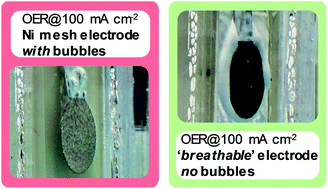Insights into the phenomenon of ‘bubble-free’ electrocatalytic oxygen evolution from water†
Abstract
Water electrolysis powered by renewable electricity will likely be critical to a future hydrogen economy. However, bubbles produced during water electrolysis add to capital and operational costs, due to blocking of the electrode surface and the necessary use of pumps and gas–liquid separators in electrolyser systems. Here ‘bubble-free’ electrocatalytic oxygen evolution from water was studied using a gas diffusion electrode that extracted oxygen as it was evolved, before bubbles were formed. The electrode comprised a gas-generating catalyst-binder layer, a poly(tetrafluoroethylene) (PTFE) interlayer, and a gas-extracting expanded PTFE (ePTFE) membrane (Gore-Tex®). Electrode properties between 20–60 °C, and with excess pressure on the alkaline electrolyte (≤80 kPa), were examined using detailed electrochemical measurements and video recordings. Electrochemical signal drift (dV/dt) was developed as a sensitive probe of bubble formation. ‘Breathability’, or the capacity for evolved oxygen to be directly extracted without forming bubbles, correlated with performance, and improved with temperature. A significant decline in oxygen evolution reaction (OER) activation energy with temperature was also observed. Bubble-free operation proceeded through the transportation of gas along a continuous network of hydrophobic, ‘aerophilic’ PTFE surfaces. The further development of bubble-free electrodes ought to permit revolutionary, low-cost electrolyser designs, adding impetus to the creation of a future hydrogen economy.



 Please wait while we load your content...
Please wait while we load your content...